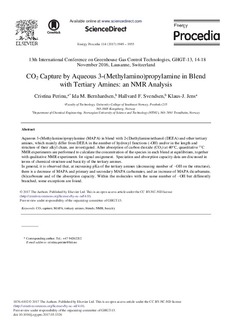| dc.contributor.author | Perinu, Cristina | |
| dc.contributor.author | Bernhardsen, Ida Mortensen | |
| dc.contributor.author | Svendsen, Hallvard Fjøsne | |
| dc.contributor.author | Jens, Klaus-Joachim | |
| dc.date.accessioned | 2017-12-01T11:39:00Z | |
| dc.date.available | 2017-12-01T11:39:00Z | |
| dc.date.created | 2017-11-02T13:03:44Z | |
| dc.date.issued | 2017 | |
| dc.identifier.citation | Energy Procedia. 2017, 114 1949-1955. | nb_NO |
| dc.identifier.issn | 1876-6102 | |
| dc.identifier.uri | http://hdl.handle.net/11250/2468773 | |
| dc.description.abstract | Aqueous 3-(Methylamino) propylamine (MAPA) in blend with 2-(Diethylamino) ethanol (DEEA) and other tertiary amines, which mainly differ from DEEA in the number of hydroxyl functions (-OH) and/or in the length and structure of their alkyl chain, are investigated. After absorption of carbon dioxide (CO2) at 40°C, quantitative 13C
NMR experiments are performed to calculate the concentration of the species in each blend at equilibrium, together with qualitative NMR experiments for signal assignment. Speciation and absorption capacity data are discussed in terms of chemical structure and basicity of the tertiary amines.
In general, it is observed that, at increasing pKa of the tertiary amines (decreasing number of –OH on the structure), there is a decrease of MAPA and primary and secondary MAPA carbamates, and an increase of MAPA dicarbamate, (bi) carbonate and of the absorption capacity. Within the molecules with the same number of –OH but differently branched, some exceptions are found. | nb_NO |
| dc.language.iso | eng | nb_NO |
| dc.rights | Attribution-NonCommercial-NoDerivatives 4.0 Internasjonal | * |
| dc.rights.uri | http://creativecommons.org/licenses/by-nc-nd/4.0/deed.no | * |
| dc.subject | CO2 capture | nb_NO |
| dc.subject | MAPA | nb_NO |
| dc.subject | tertiary amines | nb_NO |
| dc.subject | basicity | nb_NO |
| dc.subject | NMR | nb_NO |
| dc.subject | blends | nb_NO |
| dc.title | CO2 Capture by Aqueous 3-(Methylamino)propylamine in Blend with Tertiary Amines: An NMR Analysis | nb_NO |
| dc.type | Journal article | nb_NO |
| dc.type | Peer reviewed | nb_NO |
| dc.description.version | publishedVersion | nb_NO |
| dc.rights.holder | © 2017 The Authors | nb_NO |
| dc.source.pagenumber | 1949-1955 | nb_NO |
| dc.source.volume | 114 | nb_NO |
| dc.source.journal | Energy Procedia | nb_NO |
| dc.identifier.doi | 10.1016/j.egypro.2017.03.1326 | |
| dc.identifier.cristin | 1510298 | |
| cristin.unitcode | 222,58,0,0 | |
| cristin.unitcode | 222,58,3,0 | |
| cristin.unitname | Fakultet for teknologi, naturvitenskap og maritime fag | |
| cristin.unitname | Institutt for prosess-, energi- og miljøteknologi | |
| cristin.ispublished | true | |
| cristin.fulltext | original | |
| cristin.qualitycode | 1 | |

